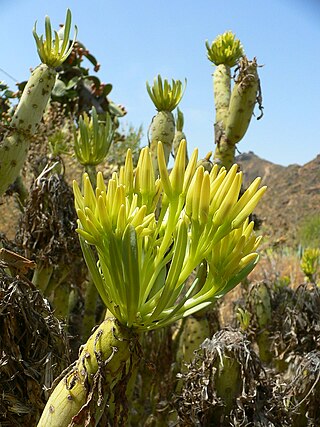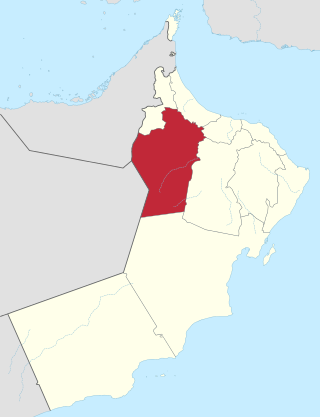
Oman, officially the Sultanate of Oman, is a country on the southeastern coast of the Arabian Peninsula in West Asia. It overlooks the mouth of the Persian Gulf. It shares land borders with Saudi Arabia, the United Arab Emirates, and Yemen. The capital and largest city is Muscat. Oman has a population of about 5.28 million as of 2024, which is a 4.60% population increase from 2023. and is the 123rd most-populous country. The coast faces the Arabian Sea on the southeast, and the Gulf of Oman on the northeast. The Madha and Musandam exclaves are surrounded by United Arab Emirates on their land borders, with the Strait of Hormuz and the Gulf of Oman forming Musandam's coastal boundaries.

Corixidae is a family of aquatic insects in the order Hemiptera. They are found worldwide in virtually any freshwater habitat and a few species live in saline water. There are about 500 known species worldwide, in 55 genera, including the genus Sigara.

The Arabian tahr is a species of tahr native to eastern Arabia. Until recently, it was placed in the genus Hemitragus, but genetic evidence supports its removal to a separate monotypic genus, Arabitragus.

Kleinia is a genus of flowering plants in the sunflower family. Kleinia contains around 50 species and is distributed from Morocco and the Canary Islands, throughout Sub-Saharan Africa, the Arabian Peninsula, South Asia and Indochina. It is closely related to the genus Senecio but is distinguished primarily by having succulent stems or leaves.

Sigara is a genus of water boatmen in the family Corixidae. Some species within this genus are halophiles; for example, occurrences of the genus have been noted in the hypersaline Makgadikgadi Pans in Botswana.
Water boatman as a type of aquatic insect can mean:

Al Dhahirah Governorate is one of the eleven governorates (muhafazah) of Oman. It was previously a region (mintaqah), and became a governorate on 28 October 2011. The largest city in the governorate is Ibri.

Sigara arguta is a species of water boatman in the family Corixidae. It is endemic to New Zealand.

Corixinae is a subfamily of aquatic bugs in the family Corixidae. There are at least 130 described species in Corixinae.
Sigara ornata is a species of water boatman in the family Corixidae. It is found in North America.
Sigara lineata is a species of water boatman in the family Corixidae. It is found in North America.
Sigara washingtonensis is a species of water boatman in the family Corixidae. It is found in North America.
Sigara mackinacensis is a species of water boatman in the family Corixidae. It is found in North America.
Sigara alternata is a species of water boatman in the family Corixidae. It is found in North America.
Sigara trilineata is a species of water boatman in the family Corixidae. It is found in North America.
Sigara mullettensis is a species of water boatman in the family Corixidae. It is found in North America.
Sigara conocephala is a species of water boatman in the family Corixidae. It is found in North America.
Sigara virginiensis is a species of water boatman in the family Corixidae. It is found in North America.

Hydrachna is a genus of mites in the family Hydrachnidae, the sole genus of the family. There are more than 80 described species in Hydrachna. Larvae of this genus are known to be parasites of water beetles such as Eretes griseus by attaching to the back of the thorax and abdomen. These water mite larvae are also hosts of Callicorixa, Corixa, Cymatia and Sigara species, although Sigara falleni has been described as "immune" to these mites, and Cymatia coleoptrata and Sigara striata also gain this "immunity" after a few years of interaction.








